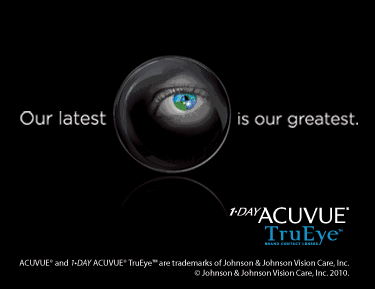|
Voluntary Recall Expanded of Select Lots of 1•Day Acuvue TruEye Outside of U.S.
Johnson & Johnson Vision Care (J&J) is expanding its voluntary recall of 1•Day Acuvue TruEye (narafilcon A) Brand Contact Lenses to include additional lots. 1•Day Acuvue TruEye Brand Contact Lenses sold in the U.S. are made with a different material, narafilcon B, and are not affected by the recall.
This action follows the company's extensive review of its manufacturing process which identified the potential for some lenses to have higher than expected levels of a processing aid linked to previous complaints in which wearers described unusual stinging or pain upon insertion.
Nearly 75 percent of the affected product is in Japan, with limited distribution in countries within Europe and Asia Pacific, as well as Canada. Regulatory authorities in all countries with affected lot numbers listed are being notified.
In August, the company announced a voluntary recall of select lots of the lenses following a limited number of complaints. During the initial investigation, the company determined that the root cause of the complaints was linked to a processing aid intended to be removed during the lens rinsing process, which was present at higher than expected levels. In addition to the recall, shipments of product from the affected manufacturing lines were immediately suspended and the company conducted extensive product testing on its inventory of 1•Day Acuvue TruEye (narafilcon A).
This additional testing revealed some variability in the manufacturing rinsing process on these affected production lines that could potentially result in lenses having higher than expected levels of the processing aid, and identified a small percentage of contact lenses in the expanded lots that do not meet internal manufacturing requirements.
Continued complaint monitoring through its post market vigilance program indicates no increase in health-related complaints related to this product variation. 1•Day Acuvue TruEye (narafilcon A) will continue to be supplied via other manufacturing lines.
Alcon Board Elects New Chairman
The Alcon, Inc. board of directors elected Dr. Daniel Vasella as its Chairman of the Board, replacing Cary Rayment who had served as chairman since May 3, 2005. Dr. Vasella is also Chairman of the Board of Novartis AG, which became Alcon's majority owner after it purchased 52% of Alcon's shares from Nestle SA on August 25, 2010, bringing its total share ownership to approximately 76%. He has served on the board of Alcon since July 7, 2008. Mr. Rayment will remain on the board and will serve as its vice-chairman.
In a separate release issued by Alcon on behalf of the Alcon Independent Director Committee (IDC), the IDC noted that the composition and mandate of the IDC remains unchanged.
Thomas G. Plaskett, Chairman of the IDC, said, "Although Alcon has a new Chairman, nothing has changed with respect to the IDC. Alcon's Organizational Regulations clearly require the IDC's prior recommendation before the Alcon Board of Directors can decide on any transaction between Alcon and Novartis. The IDC will continue to take all available and appropriate actions to ensure that this process is upheld and that the rights of Alcon's minority shareholders are protected."
| -- ADVERTISEMENT -- |

|
OAA Holds Annual Meeting
The Orthokeratology Academy of America held its annual meeting and educational conference, Vision By Design 2010, in Chicago with more than 250 attendees from 13 countries. Presentations covered a variety of topics including myopia control; corneal reshaping to correct severe myopia, hyperopia; presbyopia and high astigmatism; peripheral refraction; topographical analysis; the mechanism of Ortho-K; pediatric corneal reshaping; and crosslinking.
The general meeting was preceded by two full days of workshops and included a "bootcamp" for newcomers to corneal reshaping. Patrick Caroline was presented the "Excellence In Ortho-K" award, presented annually to an individual who has contributed significantly to the development of Ortho-K. Patrick Caroline and Earl Smith III also were awarded research fellowships for their contributions to the field of corneal reshaping.
Vision By Design 2011 will be held April 29-May 1 in Orlando, Fla. The three-day event will cover all topics of corneal reshaping and offer courses for both beginner and advanced orthokeratologists. "Boot Camp for Beginners" for both staff and doctors will be held on April 29. This meeting will include more than 10 hours of corneal reshaping education from the leading presenters in the field. For those wishing to sit for the OAA fellowship exam, preparatory courses and practical exams will be held at this meeting.
CLMA Elects New Board of Directors
At its recent annual meeting the Contact Lens Manufacturers Association (CLMA) elected their new officers and board of directors. The new officers are: President, Al Vaske, Lens Dynamics, Inc.; Vice President, Ken Leonhard, Quality Contact Lens, Inc.; Secretary-Treasurer, Jeff Duncan, Essilor USA, Inc. and Immediate Past President, Chris Pantle, DAC International, Inc.
Board members representing the Regular Membership of the CLMA include: Josh Adams, Valley Contax; Dan Bell, Corneal Design Corporation; Dan Bickers, Diversified Ophthalmics, Inc.; Keith Parker, Advanced Vision Technologies and Jan Svochak, Tru-Form Optics, Inc. The board members representing the Associate Membership of the CLMA are David Bland, Boston Products Group, Bausch + Lomb, Inc. and Tim Koch, Contamac US, Inc.
Global Specialty Lens Symposium, January 27-30, 2011, Paris Hotel & Casino in Las Vegas

Plan now to attend the Global Specialty Lens Symposium in January 2011. With an expert international faculty and a CE-accredited agenda, the 2011 GSLS will include insightful presentations by experts in the field, hands-on demonstrations of cutting-edge products as well as scientific papers and posters. Look for more detailed information in future issues of Contact Lens Spectrum and online at www.GSLSymposium.com.
--ADVERTISING
This month at www.siliconehydrogels.org: the results of the 2009 International Contact Lens Prescribing Survey, the impact of UV-absorbing silicone hydrogel lenses, fitting silicone hydrogels for patients with sub-optimal endothelial cell function, and our synopsis of silicone hydrogels at the 2009 American Academy of Optometry meeting.
|












